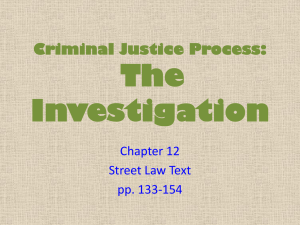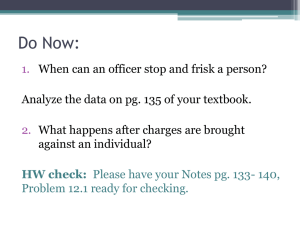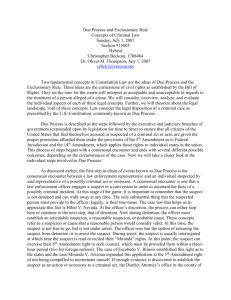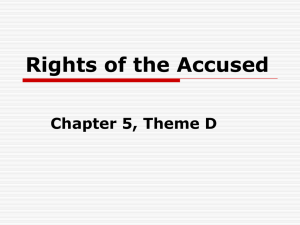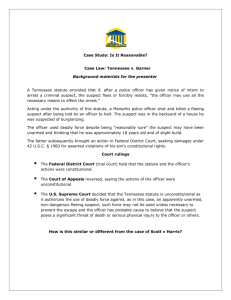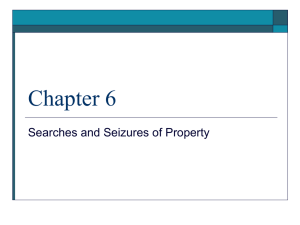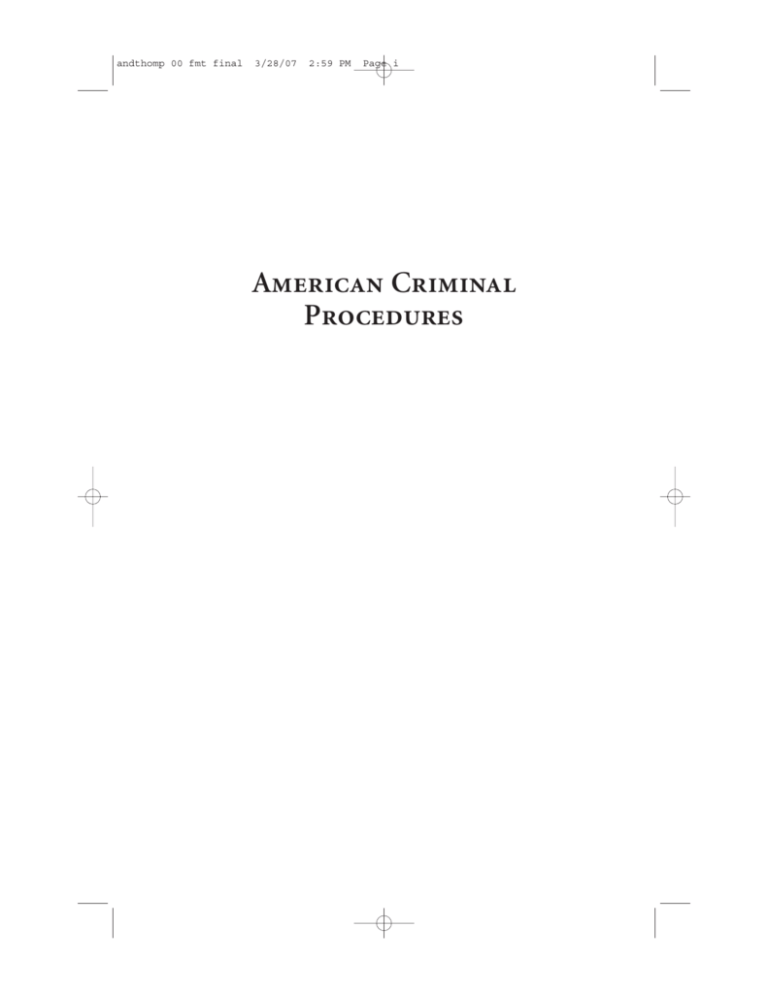
andthomp 00 fmt final
3/28/07
2:59 PM
Page i
American Criminal
Procedures
andthomp 00 fmt final
3/28/07
2:59 PM
Page ii
andthomp 00 fmt final
3/28/07
2:59 PM
Page iii
American Criminal
Procedures
James F. Anderson
Bankole Thompson
Carolina Academic Press
Durham, North Carolina
andthomp 00 fmt final
3/28/07
2:59 PM
Page iv
Copyright © 2007
James F. Anderson and Bankole Thompson
All Rights Reserved.
Library of Congress Cataloging-in-Publication Data
Anderson, James F.
American criminal procedures / by James F. Anderson, Bankole
Thompson.
p. cm.
ISBN-13: 978-1-59460-237-5
ISBN-10: 1-59460-237-9
1. Evidence, Criminal--United States. 2. Searches and seizures--United
States. 3. Arrest--United States. I. Thompson, Bankole. II. Title.
KF9660.A76 2006
345.73'05--dc22
2006017475
Carolina Academic Press
700 Kent Street
Durham, North Carolina
Tel: (919) 489-7486
Fax: (919) 493-5668
www.cap-press.com
Printed in the United States of America.
andthomp 00 fmt final
3/28/07
2:59 PM
Page v
This book is dedicated to the efforts of everyone who toils to make
justice a reality in the American criminal justice system.
andthomp 00 fmt final
3/28/07
2:59 PM
Page vi
andthomp 00 fmt final
3/28/07
2:59 PM
Page vii
Contents
Preface
About the Authors
xv
xix
Chapter 1 The Court System and Legal Rights
Focal Points
Introduction
Part One: The United States Dual Court System
Part Two: The Trial and Appellate Processes Distinguished
Part Three: The Territorial Effect of Judicial Decisions
Part Four: The Doctrine of Stare Decisis
Part Five: The Exclusivity of Federal and State Jurisdictions
Part Six: Jurisdiction and Venue Distinguished
Part Seven: Origins of Rights
Constitutions
Statutes
Case Law
Subordinate Legislation
Part Eight: The Incorporation Doctrine
Background
Doctrinal Approaches
The Concept of Fundamental Rights
Rights Amenable to Incorporation
Rights Not Amenable to Incorporation
Nationalization of the Bill of Rights
References
Cases Cited
3
3
4
5
7
8
9
10
11
12
12
14
15
15
16
16
17
17
18
19
19
19
20
Chapter 2 The Criminal Justice Process
Focal Points
Introduction
21
21
22
vii
andthomp 00 fmt final
viii
3/28/07
2:59 PM
Page viii
CONTENTS
Part One: Pretrial Process
Filing of a Complaint
Arrest
Booking
Initial Appearance Before a Magistrate
Setting of Bail
Preliminary Hearing
Prosecutorial Decision to Charge
Grand Jury Indictment and Information Differentiated
Arraignment
Plea by Defendant
Part Two: Trial Process
Selection of Jurors
Opening Statements
Presentation of Case for the Prosecution
Presentation of Case for the Defense
Rebuttal Evidence
Closing Arguments
Judge’s Instructions to Jury
Jury Deliberations
Verdict
Part Three: Posttrial Process
Sentencing
Appeal
Habeas Corpus
References
Cases Cited
Chapter 3 Probable Cause
Focal Points
Introduction
Part One: Definition of Probable Cause
Part Two: Who Determines Probable Cause?
Part Three: Factors Invalidating Arrests and Searches
Part Four: Sources of Probable Cause
Part Five: Measures Warranting Probable Cause
Part Six: Advantages of an Arrest Warrant
Part Seven: How Is Probable Cause Established?
General Guidelines
22
22
23
23
24
25
26
27
27
29
29
31
31
32
33
33
35
35
36
37
37
38
38
39
40
41
42
43
43
43
44
46
47
48
48
49
50
50
andthomp 00 fmt final
3/28/07
2:59 PM
Page ix
CONTENTS
ix
The Officer’s Own Knowledge of Facts and Circumstances
Information Given by Informants
Informant Involved in Criminal Activity
Informant Not Involved in Criminal Activity
Information Reinforced with Corroboration
Part Eight: Probable Cause and Other Standards of Proof
Differentiated
Part Nine: Probable Cause and Reasonable Suspicion Differentiated
Part Ten: Reviewability of Findings of Probable Cause and
Reasonable Suspicion
References
Cases Cited
50
51
51
53
54
Chapter 4 The Exclusionary Rule
Focal Points
Introduction
Part One: The Fourth Amendment and the Exclusionary Rule
Exclusionary Rule
Part Two: Exclusionary Rule Defined
Part Three: The History of the Exclusionary Rule
The Federal Court Level
The State Court Level
When Can the Exclusionary Rule Be Invoked?
Part Four: Exceptions to the Exclusionary Rule
Good Faith
Error Was Made by a Judge
Error Was Made by a Court Employee
Police Erroneously Believed That the Information Given to a
Magistrate Was Correct
Police Reasonably Believed That the Person Who Gave Authority
to Enter Premises Had Authority to Give Consent
Police Action Was Based on a Law That Was Later Declared
Invalid or Unconstitutional
Inevitable Discovery
Purged Taint
Independent Source
Plain View Doctrine
Searches Incidental to a Lawful Arrest
Searches with Consent
59
59
60
61
61
62
63
63
65
66
67
67
68
69
54
55
56
56
57
69
69
70
70
70
71
71
73
74
andthomp 00 fmt final
x
3/28/07
2:59 PM
Page x
CONTENTS
Part Five: Advantages and Disadvantages of the Exclusionary Rule
Advantages
Disadvantages
Part Six: Alternatives to the Exclusionary Rule
The Erosion of the Fourth Amendment and the Future of
the Exclusionary Rule
Part Seven: Some Pertinent Cases
References
Cases Cited
75
75
76
76
Chapter 5 Stop and Frisk
Focal Points
Introduction
Part One: Legal Basis for Detention
What Constitutes Reasonable Suspicion?
Part Two: Reasonable Suspicion Defined
Who Determines Reasonable Suspicion?
Factors Precipitating Reasonable Suspicion
Appearance of the Suspect
Actions of the Suspect
Area in Which the Suspect Is Observed
Part Three: Measures Warranting Reasonable Suspicion
Stop and Frisk
Leading Cases on Stop and Frisk
Part Four: Stop and Frisk Exceptions
Investigatory Automobile Stops
Automobile Stops Based on Anonymous Tips
Automobile Stops Based on Pretexts
Can Police Require Drivers and Passengers to Exit Their Vehicles?
Use of Drug Courier Profiles
Racial Profiling in Stop and Frisk
Part Five: Factors Invalidating a Stop and Frisk
Part Six: Some Pertinent Cases
References
Cases Cited
93
93
94
94
95
96
97
97
97
98
98
99
99
101
109
109
110
111
111
112
112
113
114
122
123
Chapter 6 Searches and Seizures
Focal Points
Introduction
125
125
125
77
78
89
90
andthomp 00 fmt final
3/28/07
2:59 PM
Page xi
CONTENTS
Part One: The Legal Basis for Searches and Seizures
Part Two: A Search and a Seizure Defined
Part Three: Types of Searches and Seizures
Searches and Seizures with Warrants
The Probable Cause Requirement
The Supporting Affidavit
Specificity of a Search Warrant
Signature of a Magistrate
Anticipatory Search Warrants
Executing the Search Warrant
Announcing the Warrant
Searches and Seizures without Warrants
Exceptions to the Search Warrant
Searches Incidental to a Lawful Arrest
Searches with Consent
Exigent Circumstances
Stop and Frisk
Automobiles
Items in Plain View
Searches of Airports, Borders, and Abandoned Property
Part Four: Some Pertinent Cases
References
Cases Cited
Chapter 7 Arrests
Focal Points
Introduction
Part One: Principles Governing an Arrest
The Specificity of Probable Cause
Establishing Probable Cause
Officer’s Firsthand Observations
Information Provided by an Informant
Information plus Corroboration
Part Two: The Elements of an Arrest
The Intent to Arrest a Suspect
The Authority to Arrest
Seizure and Detention
The Understanding of the Arrestee
Part Three: Arrests with and without a Warrant
xi
126
128
129
129
130
130
131
132
132
133
134
135
136
136
136
137
138
138
140
141
143
157
158
163
163
164
167
167
168
169
170
171
172
173
173
174
175
176
andthomp 00 fmt final
xii
3/28/07
2:59 PM
Page xii
CONTENTS
Arrests with a Warrant
Service of an Arrest Warrant
Search Warrants and Third-Party Premises
Legal Authorizations Analogous to an Arrest Warrant
Specificity of an Arrest Warrant
Arrests without a Warrant
Concerning Felonies
Concerning Misdemeanors
Concerning Traffic Violations
Concerning Minor Offenses Not Punishable with a Jail Term
Part Four: Legal Consequences of False Arrests and False
Imprisonment
Civil Liability under State Tort Law
Civil Liability under Federal Law
A Private Citizen’s Right to Make an Arrest
Inadmissibility of Evidence Obtained
Part Five: Invalid Actions of Police during Arrests and Legitimate
Actions of Police after Arrests
Invalid Actions of Police during Arrests
The Practice of “Media Ride-Along”
Strip or Cavity Search
Warrantless Protective Search
Legitimate Actions of Police after Arrests
Searching the Suspect
Searching the Area within the Immediate Control of the Suspect
Searching the Passenger Compartment of a Motor Vehicle
Handcuffing the Suspect
Monitoring the Movement of the Suspect
Searching the Suspect at the Place of Detention
The Disposition of Suspects after Arrest
Booking
Initial Appearance before a Magistrate
The Purposes of an Initial Appearance before a Magistrate
The Setting of Bail
Part Six: Overview of Principles Governing the Law of Arrest
Part Seven: Some Pertinent Cases
References
Cases Cited
176
178
180
180
181
182
183
185
185
185
186
186
187
189
190
190
190
190
191
191
192
193
193
194
194
194
195
195
195
196
197
197
198
199
209
211
andthomp 00 fmt final
3/28/07
2:59 PM
Page xiii
CONTENTS
xiii
Chapter 8 Field and Custodial Interrogations
Focal Points
Introduction
Part One: The Legal Basis of Custodial Interrogations
The Fifth Amendment
Self-Incrimination
Self-Incriminating Statements
The Sixth Amendment
The Right to an Attorney
From the Investigatory to the Accusatory
Miranda Rights
Waiver of Miranda Rights
Part Two: Leading Cases in Field and Custodial Interrogations
Part Three: The Protection against Self-Incrimination
Conditions When the Miranda Warnings Are Not Required
Part Four: The Erosion of Miranda v. Arizona
Part Five: Some Pertinent Cases
References
Cases Cited
213
213
213
215
215
216
216
216
216
217
218
220
221
226
228
228
234
253
254
Chapter 9 Suspect Identification Procedures
Focal Points
Introduction
Part One: Legal Basis for Suspect Identification Procedures
Part Two: Identification Procedures Defined and Classified
Part Three: External and Internal Identification Procedures
External Identification Procedures
Computer-Generated Composites
Showups
Photographic Arrangements
Lineups
Lineups: Self-Incrimination Challenge
Lineups: Right-to-Counsel Challenge
Internal Identification Procedures
Blood Samples
Dental Examination
Voice Exemplars
Handwriting Exemplars
Fingerprint Analysis
257
257
257
258
260
260
261
261
262
264
266
267
267
269
269
270
270
271
272
andthomp 00 fmt final
xiv
3/28/07
2:59 PM
Page xiv
CONTENTS
Footprint Samples
Deoxyribonucleic Acid Tests or DNA Profiling
Part Four: Some Pertinent Cases
References
Cases Cited
Index
273
273
275
283
287
287
andthomp 00 fmt final
3/27/07
2:55 PM
Page xv
Preface
The purpose of this text is twofold: first, to acquaint the reader with certain individual rights due every American citizen; and second, to educate the
reader on the legal aspects and processes that customarily unfold when citizens’ constitutional rights are challenged. More important, the text provides
the reader with the legal procedures that guide the criminal justice system in
general and the actions of police officers in particular. The book devotes specific attention to the safeguards and practices that police officers must adhere
to while discharging their sworn duty to uphold the U.S. and state constitutions. Essentially, the book presents a comprehensive examination of the legal
aspects and procedures guaranteed to criminal offenders when they are
processed through the justice system. More specifically, it lists constitutional
amendments defining what rights are given defendants, along with a chronology of pertinent U.S. Supreme Court cases that provide the Court’s rulings
and interpretations of the rule of law as it pertains to individual rights and to
rules governing law-enforcement practices.
The book is intended to be the primary text for undergraduate and graduate students enrolled in Criminal Procedures or a similarly titled college
course. It is written in a concise and straightforward style and provides many
examples so that students need not have prior knowledge of the subject matter. While some of the language may appear esoteric to non-criminal justice
majors, it will be familiar to students who know the terminologies used by
law-enforcement officers, judges, lawyers, probation and parole officers, and
other agents of the justice system.
American Criminal Procedures, a text well-researched and up-to-date, is
composed of nine chapters that provide readers with an understanding of the
criminal justice system, the legal rights of the accused, and the procedures that
follow when individual rights (or freedoms) are at issue in the system.
Chapter 1 introduces the student to the American court system. Specifically, it examines the United States dual court system, which consists of both
state and federal courts. It distinguishes between the jurisdictions of both sys-
xv
andthomp 00 fmt final
xvi
3/27/07
2:55 PM
Page xvi
PREFACE
tems and demonstrates how cases are tried before state and federal courts.
Moreover, it presents the laws that protect individual freedom and liberty as
well as those that govern police behavior. Such laws typically include the U.S.
Constitution, state constitutions, case- or judge-made law, as well as criminal
law. The chapter also discusses the amendments to the Constitution-including those in the Bill of Rights-that protect the interests of the criminally accused.
Chapter 2 addresses the processes involved in the justice system. It briefly
introduces the student to the operations of police, courts, and corrections.
Then, more specifically, it discusses the salient experiences of a suspectturned-defendant. In this chapter, special attention is given to pretrial activities such as the initial appearance, the preliminary hearing, the grand jury,
the arraignment, and plea-bargaining procedures. The chapter also explains
the processes of the trial phase as well as posttrial procedures such as sentencing. Finally, the chapter explains the appeals process and the process of
filing a habeas corpus claim.
Chapter 3 introduces the reader to an essential standard-of-proof concept
called probable cause-with which police officers, lawyers, and judges are intimately familiar. Probable cause is very important since it governs many aspects of policing. The chapter posits that many police procedures are contingent upon establishing this standard of proof. For example, according to the
Fourth Amendment, probable cause must be established before warrants may
be issued allowing legal searches and seizures and before arrests can be made.
The chapter also discusses the consequences of failing to establish probable
cause. More specifically, it discusses the importance of probable cause to the
state’s case.
Chapter 4 defines the exclusionary rule and recounts its history, beginning
with case law on the federal and state levels. The chapter further establishes
what is admissible and what is inadmissible under the rule and provides the
guidelines to which police officers must adhere in order to use evidence obtained from an arrest to gain a lawful conviction. The chapter also examines
concepts such as the fruit of the poisonous tree doctrine and the silver platter
doctrine. In addition, the chapter explores the advantages and disadvantages
of the exclusionary rule. It also examines the modification of the rule by exceptions and the impact of such exceptions on law-enforcement practices in
particular and on the criminal justice system in general. Some exceptions to
the exclusionary rule discussed in this chapter include the plain view doctrine;
good faith; the inevitable discovery rule; search incidental to a lawful arrest;
and the purged-taint exception. In its final section, the chapter discusses the
future of the exclusionary rule.
andthomp 00 fmt final
3/27/07
2:55 PM
Page xvii
PREFACE
xvii
Chapter 5 examines another concept central to conducting police workreasonable suspicion. It argues that this level of proof is needed before an officer can conduct a stop and frisk. The chapter presents the leading cases in
the area, along with other cases that have reaffirmed the courts’ position on
the issue. It further provides a detailed analysis of the procedures associated
with a stop and frisk and indicates when a suspect is free to leave the presence
of an officer who has briefly stopped and frisked the individual. The chapter
also addresses the possible consequences to officers who use a legitimate stop
to go on a “fishing expedition” of the suspect’s personal effects. In fact, the
chapter argues that police cannot haphazardly or arbitrarily stop and detain
citizens without legitimate justification. However, if police officers can establish reasonable suspicion, they are legally allowed to make brief stops to ask
questions and conduct a pat down of the suspect’s outer garments for their
own self-protection. Moreover, the chapter addresses investigatory automobile stops, automobile stops based on pretext, the use of drug-courier profiles,
racial profiling, and other factors that may invalidate stops and frisks.
Chapter 6 defines a search and a seizure. It provides the legal limits involved
in a search and examines two types of searches: those with warrants and those
without warrants. It further focuses on the process involved in procuring a
valid, or legal, search warrant. For example, it provides the procedures an officer must follow to obtain a warrant-such as filing an affidavit stating why
there is probable cause that a particular person has engaged in a specific crime
or why evidence can be found at a certain location. After filing the affidavit,
the officer must provide sworn testimony to probable cause and seek a detached magistrate who must also find probable cause. At this point, a search
warrant is issued commanding the officer either to arrest the suspect or to go
to the stated location and retrieve the evidence. The chapter also discusses the
legality of wiretaps as well as searches of people, houses, automobiles, and
borders. In addition, it addresses searches made without warrants, especially
those incidental to a lawful arrest, including consent searches.
Chapter 7 defines an arrest. It examines the leading cases that have established the point at which a person is considered under arrest and not free to
leave the control of a police officer. It further distinguishes between a valid
and an invalid arrest and explains the consequences of each. Through case history, the chapter presents the procedures used to make a valid arrest. It also
indicates the procedures that must follow an arrest: most important, the suspect must be given the Miranda warnings to avoid self-incrimination and to
safeguard his or her rights under the Fifth Amendment. In addition, the chapter connects the due process clause in the Fifth Amendment with the suspect’s
right to an attorney guaranteed by the Sixth Amendment. The chapter devotes
andthomp 00 fmt final
xviii
3/27/07
2:55 PM
Page xviii
PREFACE
special attention to the legal consequences of false arrest and false imprisonment.
Chapter 8 presents the procedures for interrogating suspects who are in police custody-either in the field or at the station house. The chapter distinguishes between confessions and admissions. Moreover, it provides case law
and a large number of court decisions establishing the guidelines which officers must follow when questioning a suspect about his or her involvement in
a crime. The chapter gives special attention to and more detailed information
about a suspect’s rights as spelled out in Miranda as well as in the Fifth and
Sixth Amendments. The chapter also examines the importance of the suspect’s
having an attorney present so that the suspect will not be coerced or deceived
into making incriminating statements that can be used to gain a criminal conviction. Finally, the chapter examines voluntary and involuntary confessions
and their admissibility in court.
Chapter 9 examines the types of identification procedures police often use
before a trial in order to identify a suspect and connect that suspect to a crime.
The chapter examines several procedures, including station-house lineups,
showups, and photographic arrangements. It further examines the constitutionality of such practices and indicates critical moments in the processes
when a suspect needs the assistance of an attorney representing his or her legal
interests. It also addresses the use of Deoxyribonucleic Acid Tests, or DNA
profiling.
andthomp 00 fmt final
3/27/07
2:55 PM
Page xix
About the Authors
James F. Anderson is currently a professor of Criminal Justice and chair of
the Criminal Justice Department at East Carolina University. He was formerly
professor of Criminal Justice and Criminology at the University of MissouriKansas City in the Department of Sociology, Criminal Justice, and Criminology. He was also associate professor of Police Studies at Eastern Kentucky University. Professor Anderson received his master’s degree in Criminology from
Alabama State University and his Ph.D. degree in Criminal Justice from Sam
Houston State University. He was a Doctoral Fellow at the National Institute
of Justice in Washington, D.C., where he engaged in a comparative recidivism
investigation of CRIPP participants, regular probationers, and parolees in
Harris County, Texas. His research interests include the areas of police liability, criminal procedure, crime and public health, criminological theory, and
legal aspects of criminal justice. He is the author of several articles and five
books. Chief among them are Legal Rights of Prisoners: Cases and Comments
and Criminological Theories: Understanding Crime in America.
Bankole Thompson is currently one of the judges of the Special Court for
Sierra Leone, a United Nations-backed war crimes tribunal. He was formerly
dean of the Graduate School at Eastern Kentucky University, from which he
is currently on leave of absence as a professor of Criminal Justice. He was also
associate professor of Criminal Justice at Kent State University, Ohio. Judge
Thompson holds the degrees of MA, LLB, Ph.D. (in Law) from the University of Cambridge, England. In his native country of Sierra Leone, he first
served as state prosecutor and then as judge of the High Court of Sierra Leone.
He was also a founding member of that country’s Law Reform Commission.
In addition, he became legal officer for the Mano River Union, West Africa.
His specialties are comparative constitutional law, comparative law, and international criminal law. He was the first African to hold the David Brennan
Chair of Comparative Constitutional Law at the Akron School of Law, Ohio.
He has to his credit several articles, book chapters, and two recently published
books, The Constitutional History and Law of Sierra Leone (1961-1995) and
The Criminal Law of Sierra Leone.
xix



